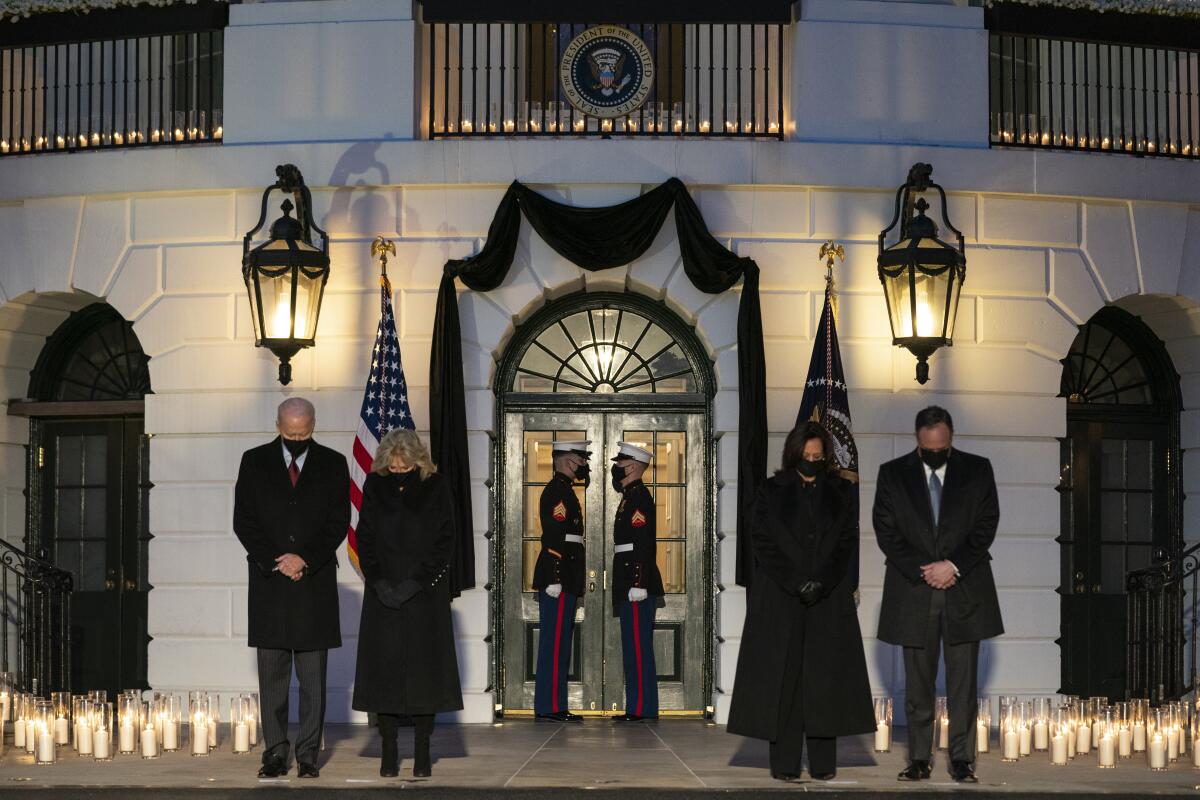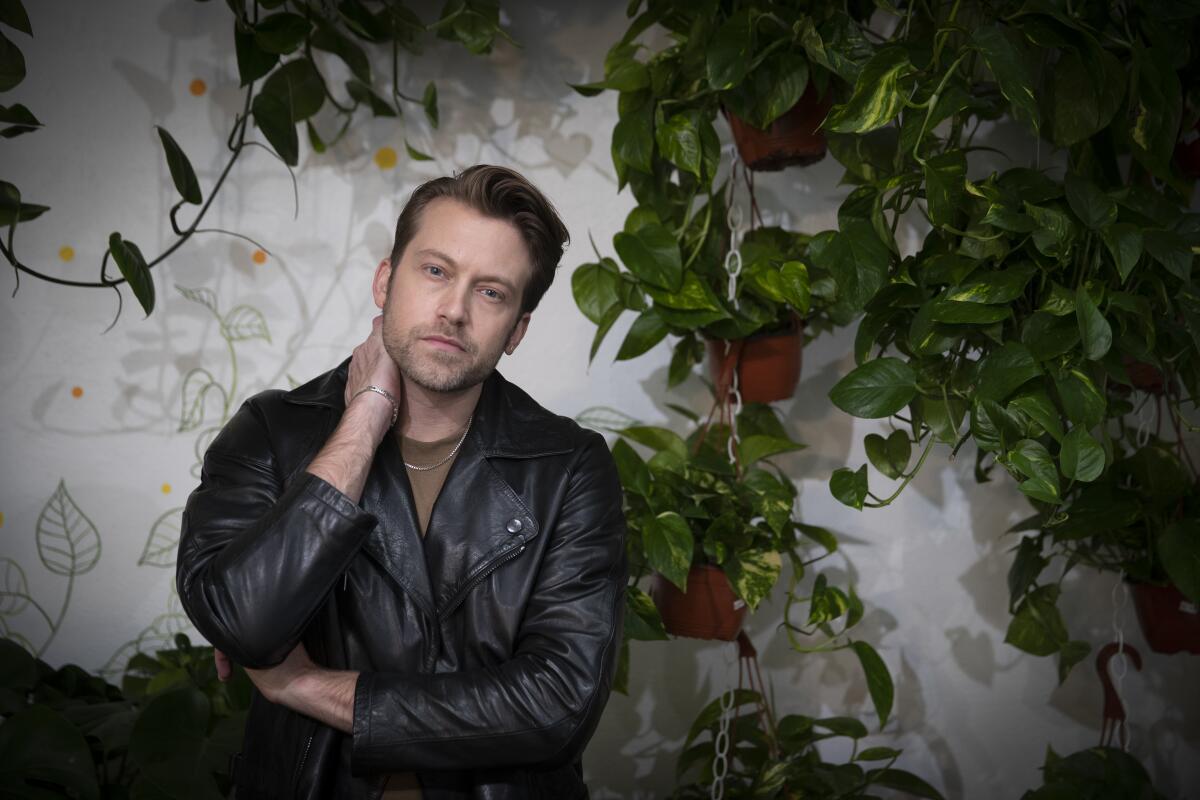Essential Arts: Artists heal our culture. But who will heal the artists?
Greetings, I’m Charles McNulty, your friendly neighborhood theater critic, pinch-hitting for my colleague (and Times arts desk all-star) Carolina A. Miranda, who’s taking a well-deserved vacation. Before I run out of baseball metaphors, allow me to fill you in on the arts stories that have gripped our attention in the last week.
A moment of silence
The nation reached a mournful milestone on Monday, surpassing 500,000 known coronavirus-related deaths. President Biden held a moment of silence for the dead, ordered flags to be flown at half-staff and, speaking as a man intimately acquainted with grief, reminded Americans that “to heal we must remember.”
Before we remember, however, we must first collectively acknowledge what is still happening — a mass casualty event every day for nearly a year. The scale of the pandemic defies comprehension but comprehend we must, if we’re to hold onto our humanity.

That’s where artists play a vital role. We rely on them to memorialize our losses for history’s sake. But we also need them to awaken us to a reality we’re still semi-sleepwalking through.
Make the most of L.A.
Get our guide to events and happenings in the SoCal arts scene. In your inbox once a week.
You may occasionally receive promotional content from the Los Angeles Times.
Information bombards us morning, noon and night; that’s not what’s missing. Artists help us process what the flood of news can’t tell us. Works of imagination, which give form to feeling, keep us from being that cynic who, in the immortal words of Oscar Wilde, knows the price of everything and the value of nothing. But to repair our broken psychological and spiritual state, artists themselves must be made financially whole.
Otis College of Art and Design released an alarming report on the economic impact of COVID-19 on the California creative economy. The level of destruction can be compared with only the Great Depression. In Los Angeles County, job losses in this sector between February and December 2020 reached 24%.
The scope of the crisis demands massive federal intervention. As U.S. Rep. Karen Bass said in her remarks at the report’s release event, “There’s no economic recovery in our area unless a working creative engine is driving it. So to rebuild after the devastating effects of COVID-19, we have to provide creative workers, both nationally and in Los Angeles, with both economic relief and recovery funding.”
But predictably, Republicans in Congress, like Sen. Marsha Blackburn of Tennessee, are up in arms that Biden’s $1.9 trillion relief bill has allocated $335 million for such apparent superfluities as museums, arts organizations and libraries. Perhaps these politicians shrewdly realize that if our culture were stronger, their hold on power would be weaker.
Still, begrudging an amount of money that amounts to little more than a rounding error of the total bill indicates a level of myopic miserliness that is itself a profound threat to national health. Unfortunately, there’s no vaccine against partisan benightedness.
Art is the preventive medicine we need, but artists, those physicians of the soul, cannot help us if we do not help them.
Healthcare hero, heal thyself with art
At least healthcare workers recognize the therapeutic value of the arts in maintaining psychic well-being. Arts writer Makeda Easter reports on doctors and nurses who have turned to painting, photography, dance and illustration to relieve the stress and strain of “Covid Fatigue,” which is the title of a painting by Dr. Frank Candela.
One of the subjects of the story, Dr. Bing Li, a medical resident and illustrator, summed up the impulse behind this artistic activity: “We all see a lot of suffering that doesn’t necessarily have a meaning. But then the desire to make art is kind of like a desire to put a meaning into something.”
(Are you a healthcare worker who has found a creative outlet for coping during the pandemic? We’d love to share your work in a follow-up story. Please submit it here.)
A new era of cultural leadership
Top posts at Los Angeles cultural institutions have been filled, and Easter has the news.
Cameron Shaw has been named executive director of the California African American Museum. For Shaw, a native Angeleno who visited the museum as a child and has served as its deputy director and chief curator since 2019, this feels like a job that she has been “called” to do. Her mission: “to support Black artistic and scholarly practices more holistically and comprehensively ... to usher revolutionary ideas into the world.”
Silas Farley, 26, an alumnus of New York City Ballet, is the new dean of Colburn School’s Trudl Zipper Dance Institute. He will be reunited with his mentor Darleen Callaghan, who has been made associate dean. Callaghan spotted Farley’s talent when, as a 9-year-old, he joined a scholarship program she created for young male dancers at the North Carolina Dance Theatre School of Dance. As Farley told Easter, he’s determined to create an environment in which students “feel that they can bring all the different dimensions of their journey and their story to their art practice” and don’t “have to check their Blackness” or “any aspect of their identity at the door.”
Changes are afoot in Long Beach as well. As Times contributor Catherine Womack reports, Long Beach Opera announced its new artistic director and chief creative officer will be James Darrah, a Los Angeles director known for producing digital classical concerts and streaming operas during COVID-19 closures. For his directorial debut with the company, Darrah will stage Philip Glass’ “Les Enfants Terribles,” part of a daring season curated by Interim Artistic Director Yuval Sharon.

Enjoying this newsletter? Consider subscribing to the Los Angeles Times
Your support helps us deliver the news that matters most. Become a subscriber.
A pandemic tale with a magical ending
Times contributor Tim Grieving has a lost-and-found story involving a bassoonist, whose beloved instrument was stolen from his car last March. Anthony Parnther, the music director of the San Bernardino Symphony, mourned the loss of his bassoon, which his mother bought when he was in high school. Her death from cancer made the bassoon all the dearer to him. The ending of this tale, without giving too much away, has some of the redemptive magic of one of Shakespeare’s romances. (Excuse me for a second while I get a Kleenex.)
Epistolary art make a comeback
Remember letters? Epistolary style may be a casualty of the digital age, in which everyone’s too busy wasting time on the internet to wait around for a piece of mail. But, as Times staff writer Julia Barajas reports, a new project pairing professional artists with students from Long Beach Unified School District finds inspiration in the poignant beauty of those envelopes that are personally addressed in a loved one’s handwriting.
“There’s something special about seeing my parents receive letters from my grandparents after being separated for decades,” acknowledged artist Diana L. Sánchez, whose work is part of the initiative. Sánchez hopes this creative exchange with young people will encourage more humane attitudes toward immigration policy in the U.S. and more compassion for those who come from elsewhere.
A master plan that needs safeguards?
Jon Christensen and Becky Nicolaides have issued an op-ed appeal on the Los Angeles River Master Plan. The part of the renewal project that concerns them “centers on a Frank Gehry-designed set of elevated platform parks over the rivers and a $150-million cultural center on the riverbank.” While Christensen and Nicolaides applaud the intention of “bringing green space and cultural resources to working-class neighborhoods,” they argue that “this revitalization effort must prioritize residents’ essential needs for affordable housing, decent jobs and local businesses, safeguarding against green gentrification.”
For your virtual delight
As usual, our indispensable Matt Cooper has compiled the week’s cultural highlights, available in these long pandemic winter days on a streaming device near you.
And last but not least ...
In the Paris Review, John Freeman has written a farewell to poet Lawrence Ferlinghetti, who died Monday at 101.
A short play by Julia Cho, written to be performed by the reader, has been published in the Yale Review. I’ve already tested it out on Zoom with my students at CalArts, who are much better actors than I am.
Finally, the stirring testimony of attorney general nominee Merrick Garland before the Senate Judiciary Committee on Monday reminded me of an overlooked detail in the judge’s superlative résumé. While at Harvard, he wrote theater reviews. With his humane brilliance, Garland could have been right up there with George Jean Nathan, Kenneth Tynan and Eric Bentley. But theater criticism’s loss has been the justice system’s gain.
The biggest entertainment stories
Get our big stories about Hollywood, film, television, music, arts, culture and more right in your inbox as soon as they publish.
You may occasionally receive promotional content from the Los Angeles Times.




